HIV in Africa: Risk Factors, Management Strategies & Recommendations
VerifiedAdded on 2023/06/09
|8
|2348
|79
Report
AI Summary
This report provides an executive summary of HIV in Africa, detailing the identification, characteristics, assessment, management, and recommendations for addressing the disease within the African population. It begins with an introduction to HIV, its symptoms, and modes of transmission, highlighting the importance of prevention and early diagnosis. The risk assessment section elaborates on factors contributing to increased vulnerability, such as sharing contaminated needles, unprotected intercourse, and pre-existing infections. It also addresses hazard characteristics through dose-response assessments of antiretroviral drugs and their potential side effects. Exposure assessment considers socio-economic factors like poverty, gender inequality, and limited access to healthcare. The risk management section focuses on strategies to control the spread of HIV, including blood testing, education, awareness campaigns, and interventions like antiretroviral therapy and condom use. It also emphasizes the role of government policies in minimizing the disease's impact. The report recommends incorporating free mandatory HIV testing in hospitals, promoting regular sexually transmitted disease testing for couples, and encouraging healthy lifestyles for HIV-positive individuals. Finally, a press release statement summarizes the key findings and recommendations, aiming to inform and update the general population on the unique risks and management strategies related to HIV in Africa, while also dispelling misconceptions and promoting compassionate treatment of infected individuals.
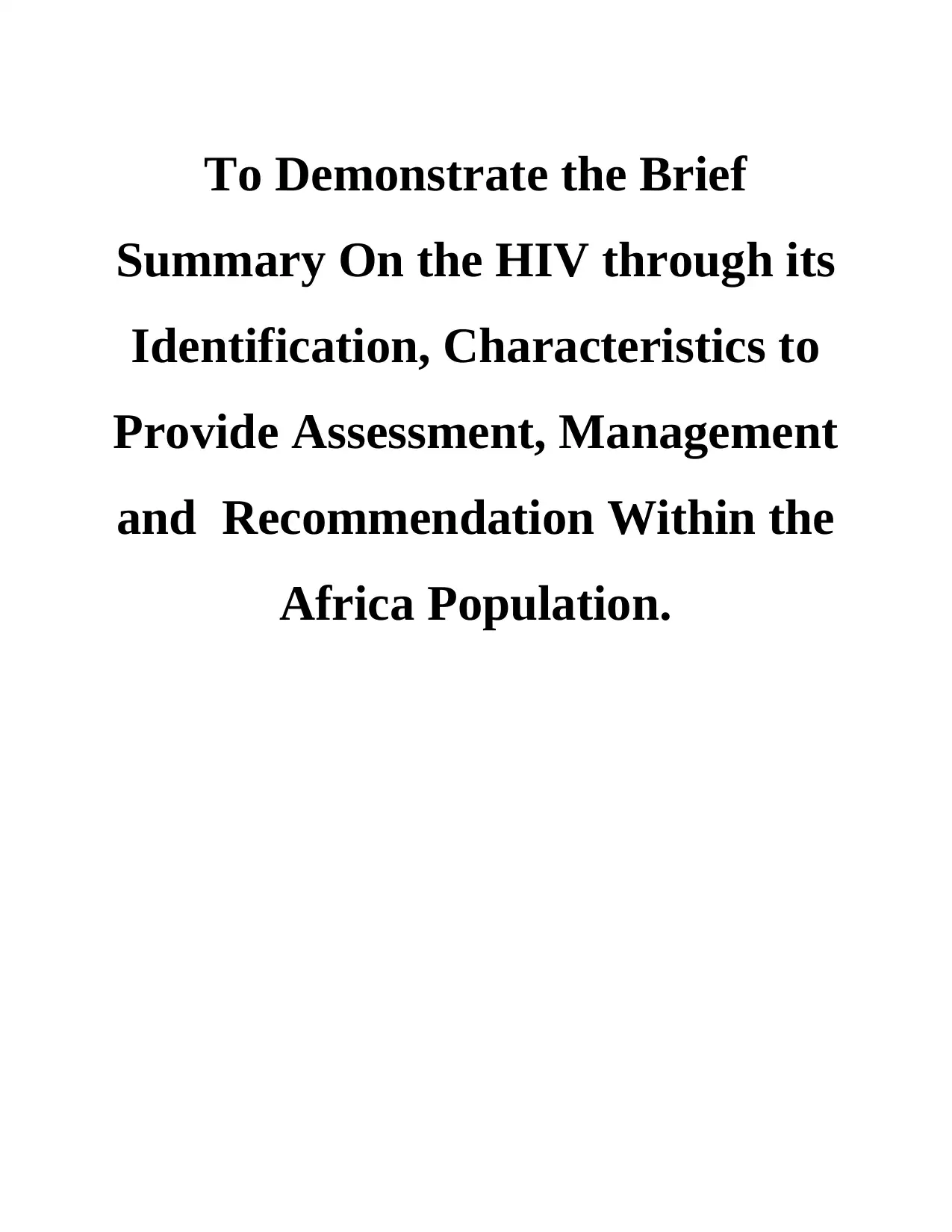
To Demonstrate the Brief
Summary On the HIV through its
Identification, Characteristics to
Provide Assessment, Management
and Recommendation Within the
Africa Population.
Summary On the HIV through its
Identification, Characteristics to
Provide Assessment, Management
and Recommendation Within the
Africa Population.
Paraphrase This Document
Need a fresh take? Get an instant paraphrase of this document with our AI Paraphraser
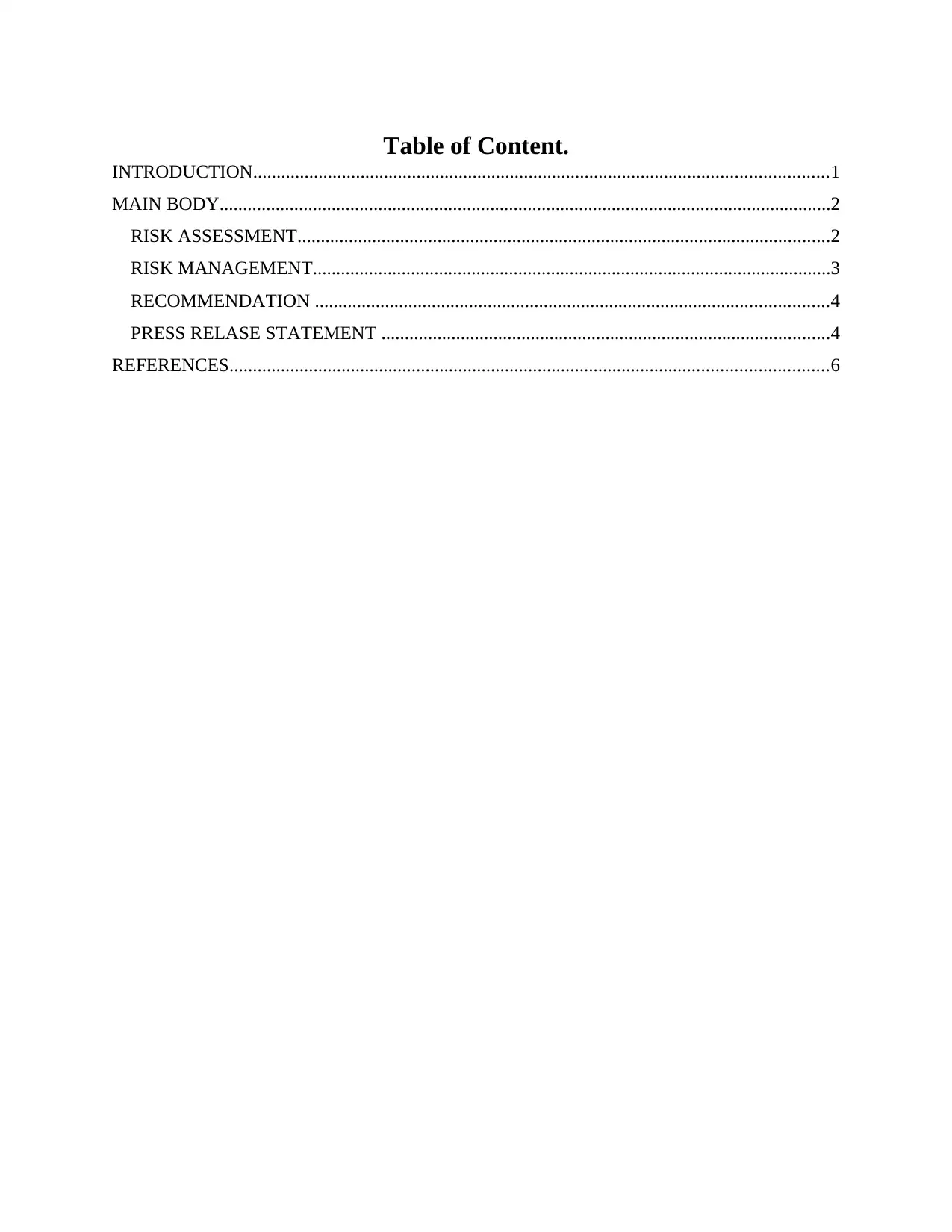
Table of Content.
INTRODUCTION...........................................................................................................................1
MAIN BODY...................................................................................................................................2
RISK ASSESSMENT..................................................................................................................2
RISK MANAGEMENT...............................................................................................................3
RECOMMENDATION ..............................................................................................................4
PRESS RELASE STATEMENT ................................................................................................4
REFERENCES................................................................................................................................6
INTRODUCTION...........................................................................................................................1
MAIN BODY...................................................................................................................................2
RISK ASSESSMENT..................................................................................................................2
RISK MANAGEMENT...............................................................................................................3
RECOMMENDATION ..............................................................................................................4
PRESS RELASE STATEMENT ................................................................................................4
REFERENCES................................................................................................................................6
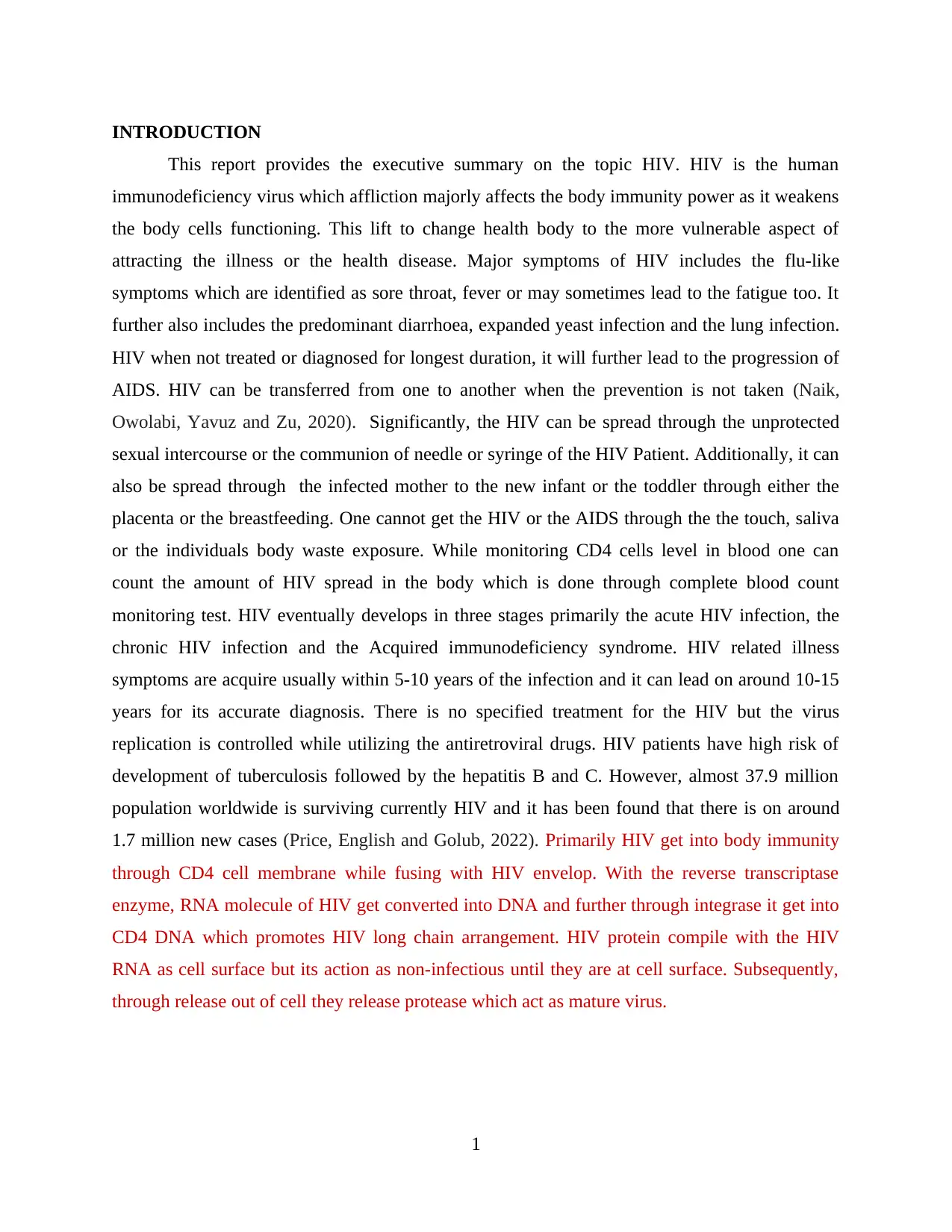
INTRODUCTION
This report provides the executive summary on the topic HIV. HIV is the human
immunodeficiency virus which affliction majorly affects the body immunity power as it weakens
the body cells functioning. This lift to change health body to the more vulnerable aspect of
attracting the illness or the health disease. Major symptoms of HIV includes the flu-like
symptoms which are identified as sore throat, fever or may sometimes lead to the fatigue too. It
further also includes the predominant diarrhoea, expanded yeast infection and the lung infection.
HIV when not treated or diagnosed for longest duration, it will further lead to the progression of
AIDS. HIV can be transferred from one to another when the prevention is not taken (Naik,
Owolabi, Yavuz and Zu, 2020). Significantly, the HIV can be spread through the unprotected
sexual intercourse or the communion of needle or syringe of the HIV Patient. Additionally, it can
also be spread through the infected mother to the new infant or the toddler through either the
placenta or the breastfeeding. One cannot get the HIV or the AIDS through the the touch, saliva
or the individuals body waste exposure. While monitoring CD4 cells level in blood one can
count the amount of HIV spread in the body which is done through complete blood count
monitoring test. HIV eventually develops in three stages primarily the acute HIV infection, the
chronic HIV infection and the Acquired immunodeficiency syndrome. HIV related illness
symptoms are acquire usually within 5-10 years of the infection and it can lead on around 10-15
years for its accurate diagnosis. There is no specified treatment for the HIV but the virus
replication is controlled while utilizing the antiretroviral drugs. HIV patients have high risk of
development of tuberculosis followed by the hepatitis B and C. However, almost 37.9 million
population worldwide is surviving currently HIV and it has been found that there is on around
1.7 million new cases (Price, English and Golub, 2022). Primarily HIV get into body immunity
through CD4 cell membrane while fusing with HIV envelop. With the reverse transcriptase
enzyme, RNA molecule of HIV get converted into DNA and further through integrase it get into
CD4 DNA which promotes HIV long chain arrangement. HIV protein compile with the HIV
RNA as cell surface but its action as non-infectious until they are at cell surface. Subsequently,
through release out of cell they release protease which act as mature virus.
1
This report provides the executive summary on the topic HIV. HIV is the human
immunodeficiency virus which affliction majorly affects the body immunity power as it weakens
the body cells functioning. This lift to change health body to the more vulnerable aspect of
attracting the illness or the health disease. Major symptoms of HIV includes the flu-like
symptoms which are identified as sore throat, fever or may sometimes lead to the fatigue too. It
further also includes the predominant diarrhoea, expanded yeast infection and the lung infection.
HIV when not treated or diagnosed for longest duration, it will further lead to the progression of
AIDS. HIV can be transferred from one to another when the prevention is not taken (Naik,
Owolabi, Yavuz and Zu, 2020). Significantly, the HIV can be spread through the unprotected
sexual intercourse or the communion of needle or syringe of the HIV Patient. Additionally, it can
also be spread through the infected mother to the new infant or the toddler through either the
placenta or the breastfeeding. One cannot get the HIV or the AIDS through the the touch, saliva
or the individuals body waste exposure. While monitoring CD4 cells level in blood one can
count the amount of HIV spread in the body which is done through complete blood count
monitoring test. HIV eventually develops in three stages primarily the acute HIV infection, the
chronic HIV infection and the Acquired immunodeficiency syndrome. HIV related illness
symptoms are acquire usually within 5-10 years of the infection and it can lead on around 10-15
years for its accurate diagnosis. There is no specified treatment for the HIV but the virus
replication is controlled while utilizing the antiretroviral drugs. HIV patients have high risk of
development of tuberculosis followed by the hepatitis B and C. However, almost 37.9 million
population worldwide is surviving currently HIV and it has been found that there is on around
1.7 million new cases (Price, English and Golub, 2022). Primarily HIV get into body immunity
through CD4 cell membrane while fusing with HIV envelop. With the reverse transcriptase
enzyme, RNA molecule of HIV get converted into DNA and further through integrase it get into
CD4 DNA which promotes HIV long chain arrangement. HIV protein compile with the HIV
RNA as cell surface but its action as non-infectious until they are at cell surface. Subsequently,
through release out of cell they release protease which act as mature virus.
1
⊘ This is a preview!⊘
Do you want full access?
Subscribe today to unlock all pages.

Trusted by 1+ million students worldwide
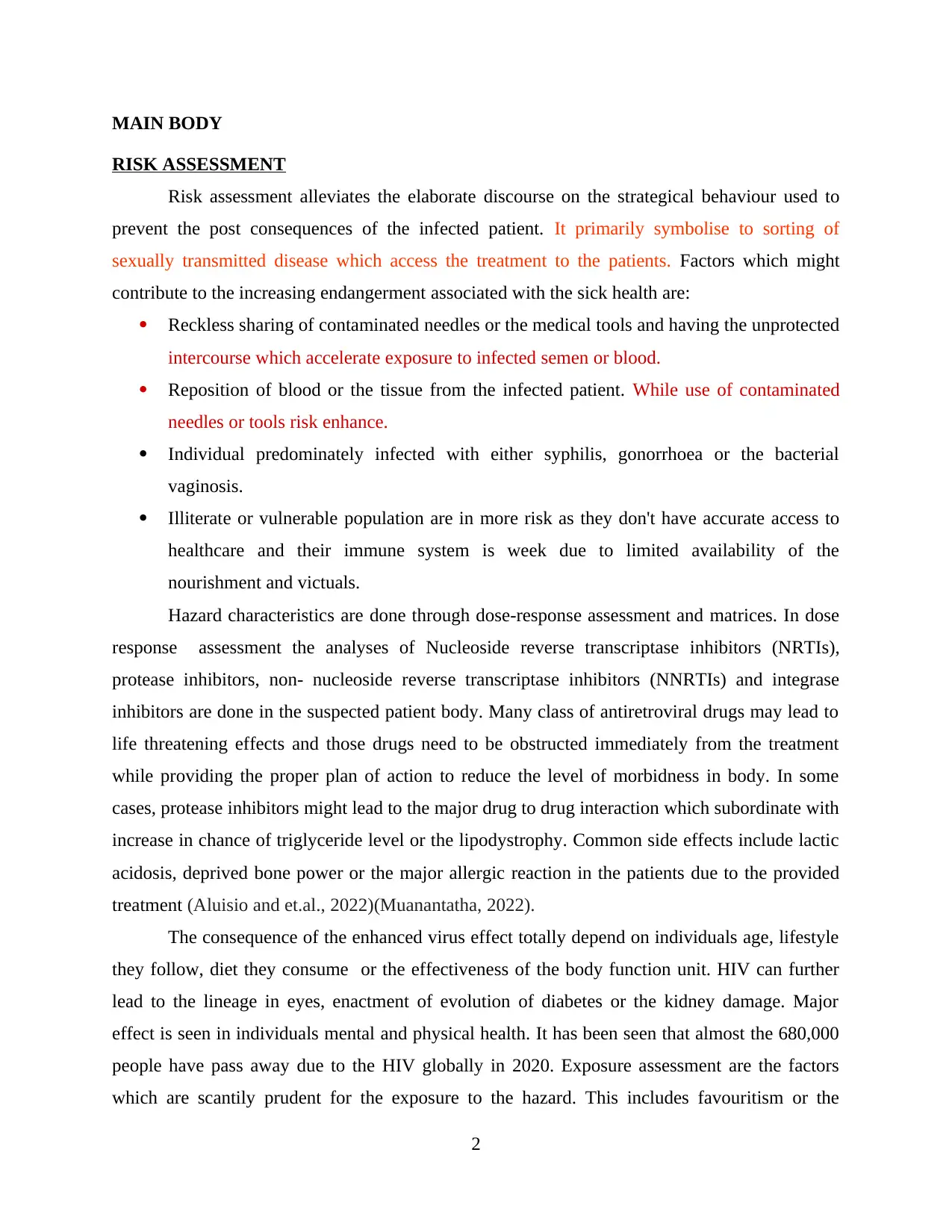
MAIN BODY
RISK ASSESSMENT
Risk assessment alleviates the elaborate discourse on the strategical behaviour used to
prevent the post consequences of the infected patient. It primarily symbolise to sorting of
sexually transmitted disease which access the treatment to the patients. Factors which might
contribute to the increasing endangerment associated with the sick health are:
Reckless sharing of contaminated needles or the medical tools and having the unprotected
intercourse which accelerate exposure to infected semen or blood.
Reposition of blood or the tissue from the infected patient. While use of contaminated
needles or tools risk enhance.
Individual predominately infected with either syphilis, gonorrhoea or the bacterial
vaginosis.
Illiterate or vulnerable population are in more risk as they don't have accurate access to
healthcare and their immune system is week due to limited availability of the
nourishment and victuals.
Hazard characteristics are done through dose-response assessment and matrices. In dose
response assessment the analyses of Nucleoside reverse transcriptase inhibitors (NRTIs),
protease inhibitors, non- nucleoside reverse transcriptase inhibitors (NNRTIs) and integrase
inhibitors are done in the suspected patient body. Many class of antiretroviral drugs may lead to
life threatening effects and those drugs need to be obstructed immediately from the treatment
while providing the proper plan of action to reduce the level of morbidness in body. In some
cases, protease inhibitors might lead to the major drug to drug interaction which subordinate with
increase in chance of triglyceride level or the lipodystrophy. Common side effects include lactic
acidosis, deprived bone power or the major allergic reaction in the patients due to the provided
treatment (Aluisio and et.al., 2022)(Muanantatha, 2022).
The consequence of the enhanced virus effect totally depend on individuals age, lifestyle
they follow, diet they consume or the effectiveness of the body function unit. HIV can further
lead to the lineage in eyes, enactment of evolution of diabetes or the kidney damage. Major
effect is seen in individuals mental and physical health. It has been seen that almost the 680,000
people have pass away due to the HIV globally in 2020. Exposure assessment are the factors
which are scantily prudent for the exposure to the hazard. This includes favouritism or the
2
RISK ASSESSMENT
Risk assessment alleviates the elaborate discourse on the strategical behaviour used to
prevent the post consequences of the infected patient. It primarily symbolise to sorting of
sexually transmitted disease which access the treatment to the patients. Factors which might
contribute to the increasing endangerment associated with the sick health are:
Reckless sharing of contaminated needles or the medical tools and having the unprotected
intercourse which accelerate exposure to infected semen or blood.
Reposition of blood or the tissue from the infected patient. While use of contaminated
needles or tools risk enhance.
Individual predominately infected with either syphilis, gonorrhoea or the bacterial
vaginosis.
Illiterate or vulnerable population are in more risk as they don't have accurate access to
healthcare and their immune system is week due to limited availability of the
nourishment and victuals.
Hazard characteristics are done through dose-response assessment and matrices. In dose
response assessment the analyses of Nucleoside reverse transcriptase inhibitors (NRTIs),
protease inhibitors, non- nucleoside reverse transcriptase inhibitors (NNRTIs) and integrase
inhibitors are done in the suspected patient body. Many class of antiretroviral drugs may lead to
life threatening effects and those drugs need to be obstructed immediately from the treatment
while providing the proper plan of action to reduce the level of morbidness in body. In some
cases, protease inhibitors might lead to the major drug to drug interaction which subordinate with
increase in chance of triglyceride level or the lipodystrophy. Common side effects include lactic
acidosis, deprived bone power or the major allergic reaction in the patients due to the provided
treatment (Aluisio and et.al., 2022)(Muanantatha, 2022).
The consequence of the enhanced virus effect totally depend on individuals age, lifestyle
they follow, diet they consume or the effectiveness of the body function unit. HIV can further
lead to the lineage in eyes, enactment of evolution of diabetes or the kidney damage. Major
effect is seen in individuals mental and physical health. It has been seen that almost the 680,000
people have pass away due to the HIV globally in 2020. Exposure assessment are the factors
which are scantily prudent for the exposure to the hazard. This includes favouritism or the
2
Paraphrase This Document
Need a fresh take? Get an instant paraphrase of this document with our AI Paraphraser
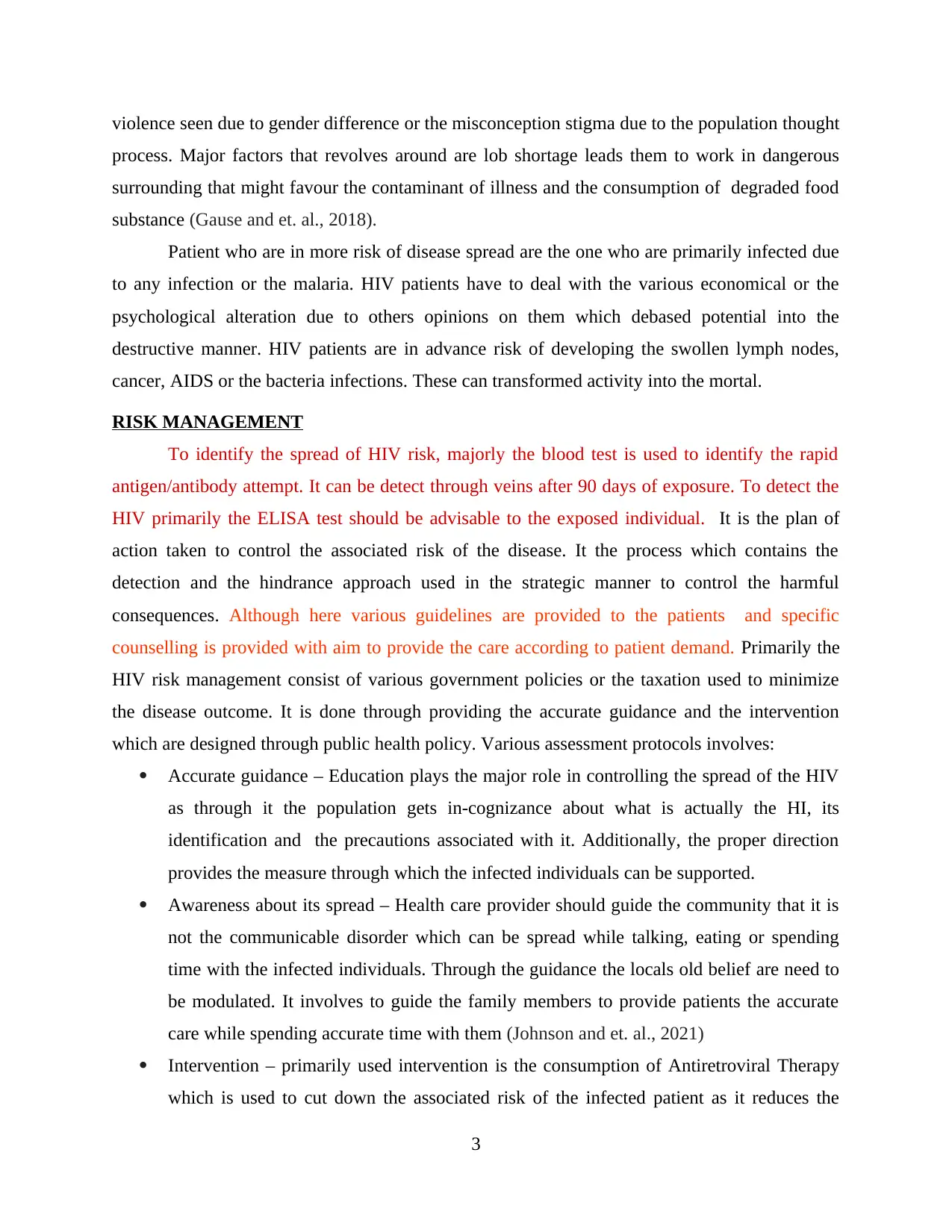
violence seen due to gender difference or the misconception stigma due to the population thought
process. Major factors that revolves around are lob shortage leads them to work in dangerous
surrounding that might favour the contaminant of illness and the consumption of degraded food
substance (Gause and et. al., 2018).
Patient who are in more risk of disease spread are the one who are primarily infected due
to any infection or the malaria. HIV patients have to deal with the various economical or the
psychological alteration due to others opinions on them which debased potential into the
destructive manner. HIV patients are in advance risk of developing the swollen lymph nodes,
cancer, AIDS or the bacteria infections. These can transformed activity into the mortal.
RISK MANAGEMENT
To identify the spread of HIV risk, majorly the blood test is used to identify the rapid
antigen/antibody attempt. It can be detect through veins after 90 days of exposure. To detect the
HIV primarily the ELISA test should be advisable to the exposed individual. It is the plan of
action taken to control the associated risk of the disease. It the process which contains the
detection and the hindrance approach used in the strategic manner to control the harmful
consequences. Although here various guidelines are provided to the patients and specific
counselling is provided with aim to provide the care according to patient demand. Primarily the
HIV risk management consist of various government policies or the taxation used to minimize
the disease outcome. It is done through providing the accurate guidance and the intervention
which are designed through public health policy. Various assessment protocols involves:
Accurate guidance – Education plays the major role in controlling the spread of the HIV
as through it the population gets in-cognizance about what is actually the HI, its
identification and the precautions associated with it. Additionally, the proper direction
provides the measure through which the infected individuals can be supported.
Awareness about its spread – Health care provider should guide the community that it is
not the communicable disorder which can be spread while talking, eating or spending
time with the infected individuals. Through the guidance the locals old belief are need to
be modulated. It involves to guide the family members to provide patients the accurate
care while spending accurate time with them (Johnson and et. al., 2021)
Intervention – primarily used intervention is the consumption of Antiretroviral Therapy
which is used to cut down the associated risk of the infected patient as it reduces the
3
process. Major factors that revolves around are lob shortage leads them to work in dangerous
surrounding that might favour the contaminant of illness and the consumption of degraded food
substance (Gause and et. al., 2018).
Patient who are in more risk of disease spread are the one who are primarily infected due
to any infection or the malaria. HIV patients have to deal with the various economical or the
psychological alteration due to others opinions on them which debased potential into the
destructive manner. HIV patients are in advance risk of developing the swollen lymph nodes,
cancer, AIDS or the bacteria infections. These can transformed activity into the mortal.
RISK MANAGEMENT
To identify the spread of HIV risk, majorly the blood test is used to identify the rapid
antigen/antibody attempt. It can be detect through veins after 90 days of exposure. To detect the
HIV primarily the ELISA test should be advisable to the exposed individual. It is the plan of
action taken to control the associated risk of the disease. It the process which contains the
detection and the hindrance approach used in the strategic manner to control the harmful
consequences. Although here various guidelines are provided to the patients and specific
counselling is provided with aim to provide the care according to patient demand. Primarily the
HIV risk management consist of various government policies or the taxation used to minimize
the disease outcome. It is done through providing the accurate guidance and the intervention
which are designed through public health policy. Various assessment protocols involves:
Accurate guidance – Education plays the major role in controlling the spread of the HIV
as through it the population gets in-cognizance about what is actually the HI, its
identification and the precautions associated with it. Additionally, the proper direction
provides the measure through which the infected individuals can be supported.
Awareness about its spread – Health care provider should guide the community that it is
not the communicable disorder which can be spread while talking, eating or spending
time with the infected individuals. Through the guidance the locals old belief are need to
be modulated. It involves to guide the family members to provide patients the accurate
care while spending accurate time with them (Johnson and et. al., 2021)
Intervention – primarily used intervention is the consumption of Antiretroviral Therapy
which is used to cut down the associated risk of the infected patient as it reduces the
3
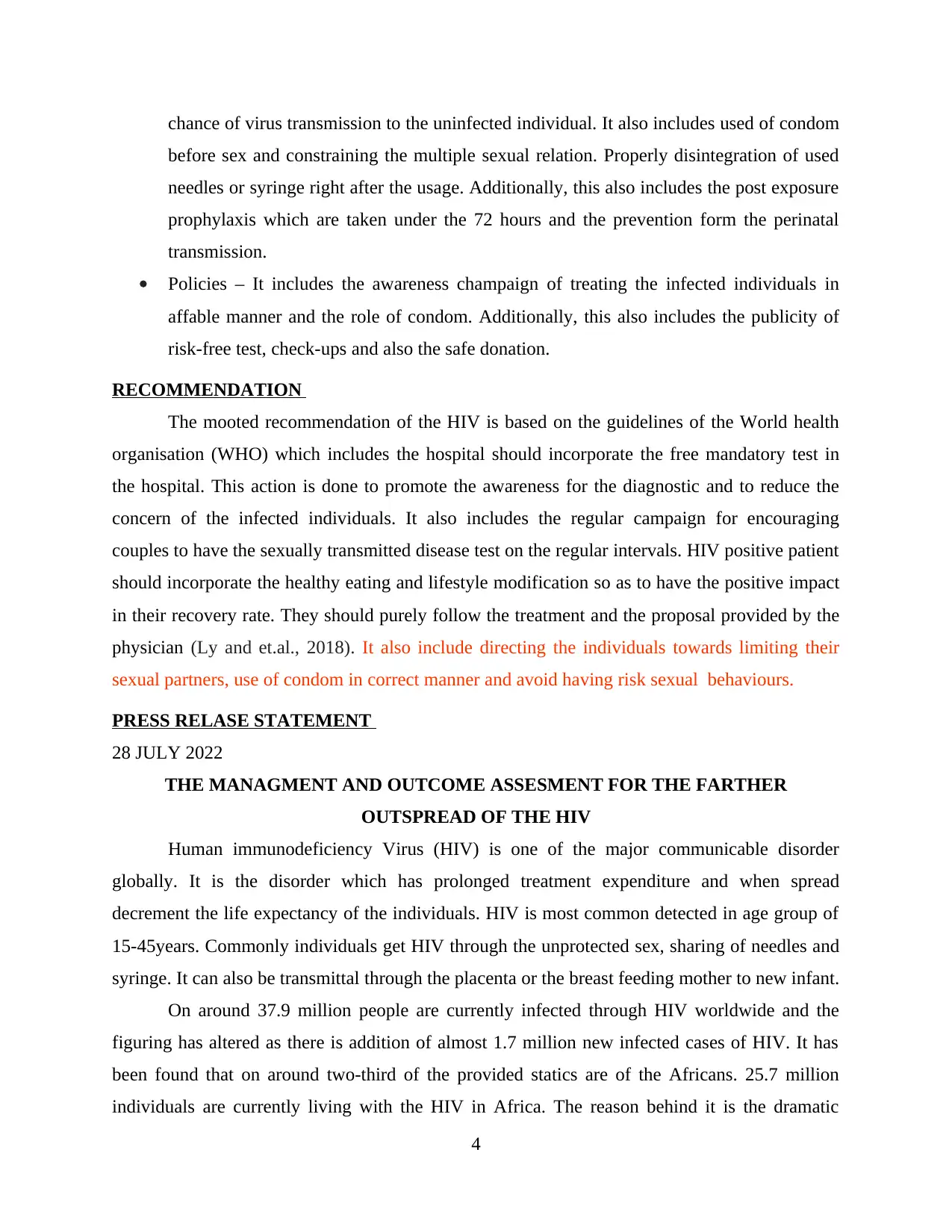
chance of virus transmission to the uninfected individual. It also includes used of condom
before sex and constraining the multiple sexual relation. Properly disintegration of used
needles or syringe right after the usage. Additionally, this also includes the post exposure
prophylaxis which are taken under the 72 hours and the prevention form the perinatal
transmission.
Policies – It includes the awareness champaign of treating the infected individuals in
affable manner and the role of condom. Additionally, this also includes the publicity of
risk-free test, check-ups and also the safe donation.
RECOMMENDATION
The mooted recommendation of the HIV is based on the guidelines of the World health
organisation (WHO) which includes the hospital should incorporate the free mandatory test in
the hospital. This action is done to promote the awareness for the diagnostic and to reduce the
concern of the infected individuals. It also includes the regular campaign for encouraging
couples to have the sexually transmitted disease test on the regular intervals. HIV positive patient
should incorporate the healthy eating and lifestyle modification so as to have the positive impact
in their recovery rate. They should purely follow the treatment and the proposal provided by the
physician (Ly and et.al., 2018). It also include directing the individuals towards limiting their
sexual partners, use of condom in correct manner and avoid having risk sexual behaviours.
PRESS RELASE STATEMENT
28 JULY 2022
THE MANAGMENT AND OUTCOME ASSESMENT FOR THE FARTHER
OUTSPREAD OF THE HIV
Human immunodeficiency Virus (HIV) is one of the major communicable disorder
globally. It is the disorder which has prolonged treatment expenditure and when spread
decrement the life expectancy of the individuals. HIV is most common detected in age group of
15-45years. Commonly individuals get HIV through the unprotected sex, sharing of needles and
syringe. It can also be transmittal through the placenta or the breast feeding mother to new infant.
On around 37.9 million people are currently infected through HIV worldwide and the
figuring has altered as there is addition of almost 1.7 million new infected cases of HIV. It has
been found that on around two-third of the provided statics are of the Africans. 25.7 million
individuals are currently living with the HIV in Africa. The reason behind it is the dramatic
4
before sex and constraining the multiple sexual relation. Properly disintegration of used
needles or syringe right after the usage. Additionally, this also includes the post exposure
prophylaxis which are taken under the 72 hours and the prevention form the perinatal
transmission.
Policies – It includes the awareness champaign of treating the infected individuals in
affable manner and the role of condom. Additionally, this also includes the publicity of
risk-free test, check-ups and also the safe donation.
RECOMMENDATION
The mooted recommendation of the HIV is based on the guidelines of the World health
organisation (WHO) which includes the hospital should incorporate the free mandatory test in
the hospital. This action is done to promote the awareness for the diagnostic and to reduce the
concern of the infected individuals. It also includes the regular campaign for encouraging
couples to have the sexually transmitted disease test on the regular intervals. HIV positive patient
should incorporate the healthy eating and lifestyle modification so as to have the positive impact
in their recovery rate. They should purely follow the treatment and the proposal provided by the
physician (Ly and et.al., 2018). It also include directing the individuals towards limiting their
sexual partners, use of condom in correct manner and avoid having risk sexual behaviours.
PRESS RELASE STATEMENT
28 JULY 2022
THE MANAGMENT AND OUTCOME ASSESMENT FOR THE FARTHER
OUTSPREAD OF THE HIV
Human immunodeficiency Virus (HIV) is one of the major communicable disorder
globally. It is the disorder which has prolonged treatment expenditure and when spread
decrement the life expectancy of the individuals. HIV is most common detected in age group of
15-45years. Commonly individuals get HIV through the unprotected sex, sharing of needles and
syringe. It can also be transmittal through the placenta or the breast feeding mother to new infant.
On around 37.9 million people are currently infected through HIV worldwide and the
figuring has altered as there is addition of almost 1.7 million new infected cases of HIV. It has
been found that on around two-third of the provided statics are of the Africans. 25.7 million
individuals are currently living with the HIV in Africa. The reason behind it is the dramatic
4
⊘ This is a preview!⊘
Do you want full access?
Subscribe today to unlock all pages.

Trusted by 1+ million students worldwide
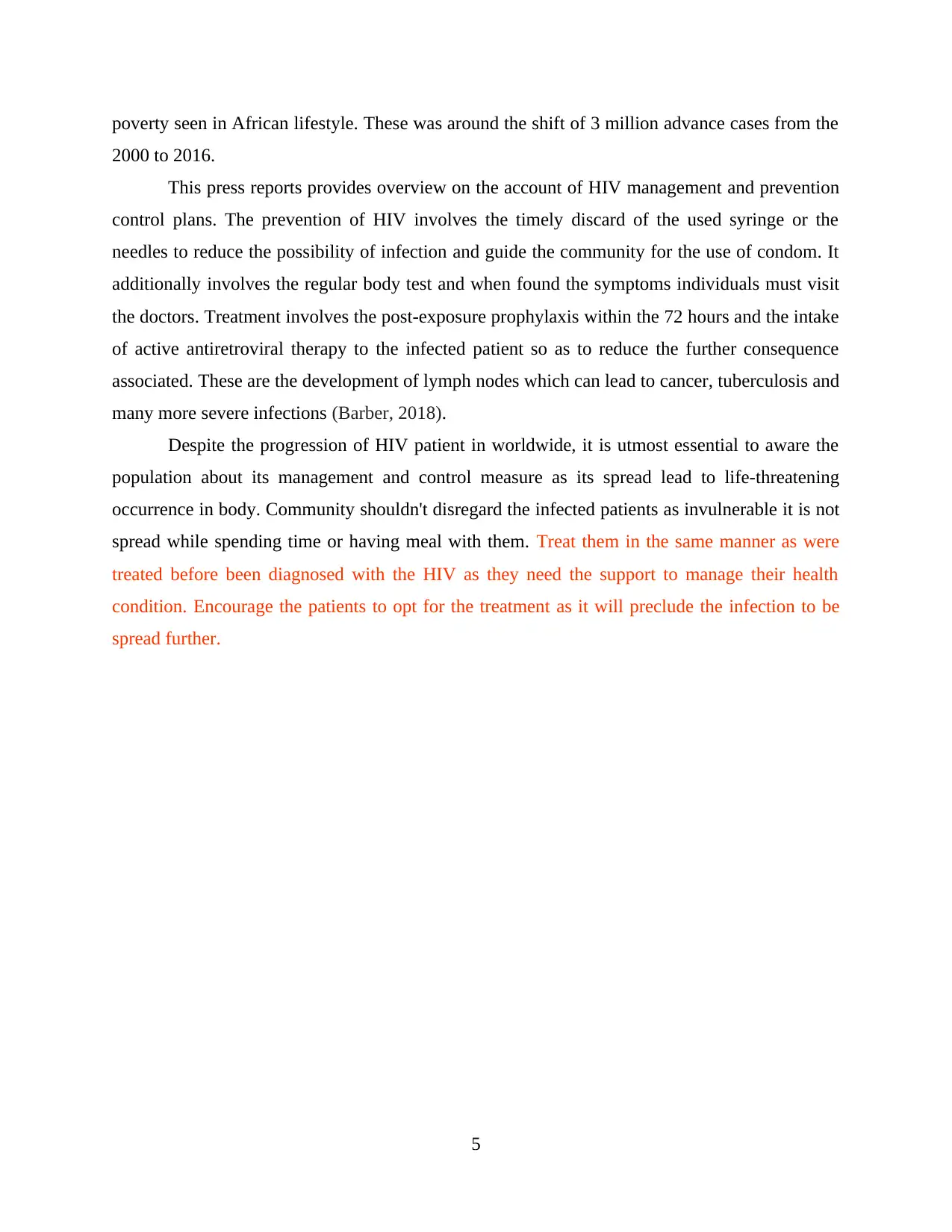
poverty seen in African lifestyle. These was around the shift of 3 million advance cases from the
2000 to 2016.
This press reports provides overview on the account of HIV management and prevention
control plans. The prevention of HIV involves the timely discard of the used syringe or the
needles to reduce the possibility of infection and guide the community for the use of condom. It
additionally involves the regular body test and when found the symptoms individuals must visit
the doctors. Treatment involves the post-exposure prophylaxis within the 72 hours and the intake
of active antiretroviral therapy to the infected patient so as to reduce the further consequence
associated. These are the development of lymph nodes which can lead to cancer, tuberculosis and
many more severe infections (Barber, 2018).
Despite the progression of HIV patient in worldwide, it is utmost essential to aware the
population about its management and control measure as its spread lead to life-threatening
occurrence in body. Community shouldn't disregard the infected patients as invulnerable it is not
spread while spending time or having meal with them. Treat them in the same manner as were
treated before been diagnosed with the HIV as they need the support to manage their health
condition. Encourage the patients to opt for the treatment as it will preclude the infection to be
spread further.
5
2000 to 2016.
This press reports provides overview on the account of HIV management and prevention
control plans. The prevention of HIV involves the timely discard of the used syringe or the
needles to reduce the possibility of infection and guide the community for the use of condom. It
additionally involves the regular body test and when found the symptoms individuals must visit
the doctors. Treatment involves the post-exposure prophylaxis within the 72 hours and the intake
of active antiretroviral therapy to the infected patient so as to reduce the further consequence
associated. These are the development of lymph nodes which can lead to cancer, tuberculosis and
many more severe infections (Barber, 2018).
Despite the progression of HIV patient in worldwide, it is utmost essential to aware the
population about its management and control measure as its spread lead to life-threatening
occurrence in body. Community shouldn't disregard the infected patients as invulnerable it is not
spread while spending time or having meal with them. Treat them in the same manner as were
treated before been diagnosed with the HIV as they need the support to manage their health
condition. Encourage the patients to opt for the treatment as it will preclude the infection to be
spread further.
5
Paraphrase This Document
Need a fresh take? Get an instant paraphrase of this document with our AI Paraphraser
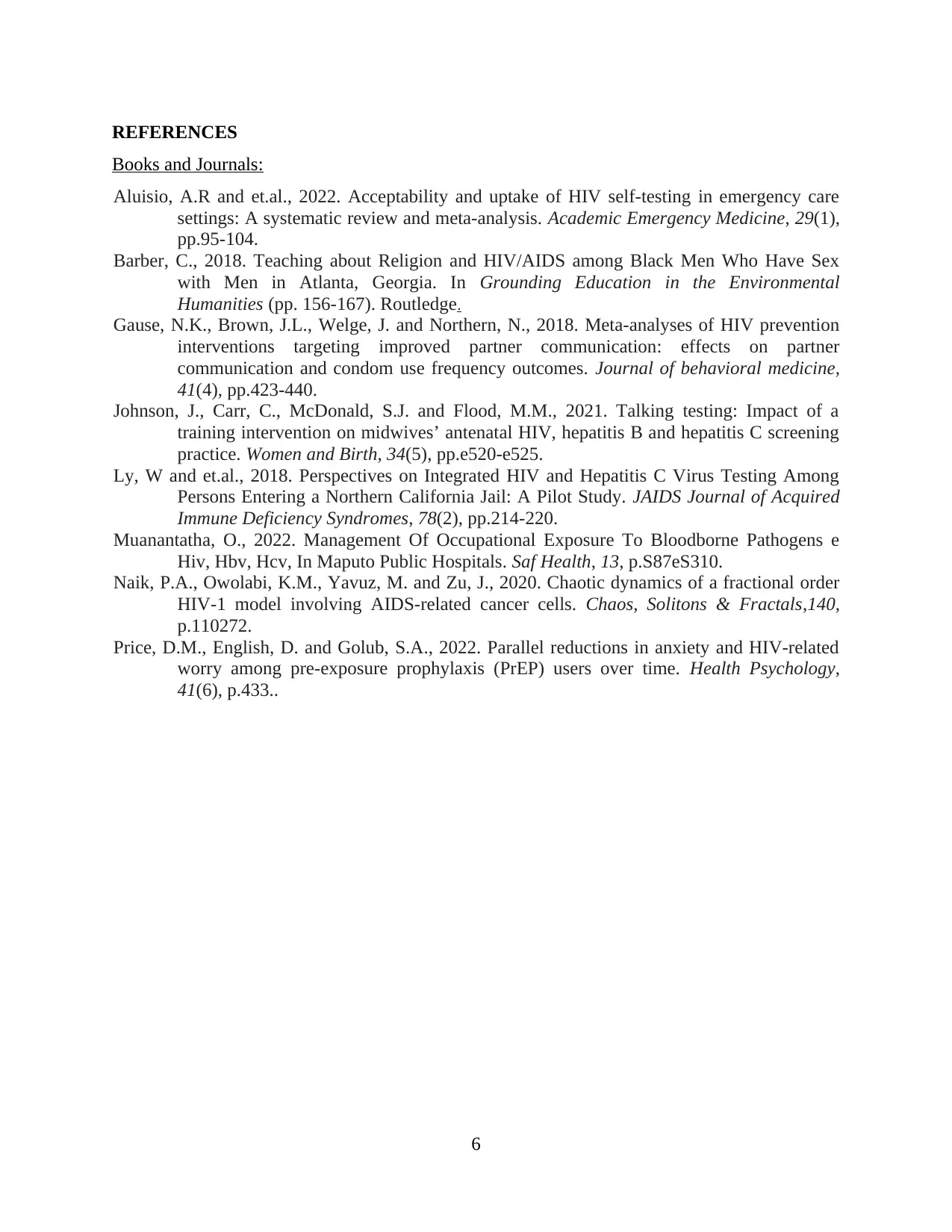
REFERENCES
Books and Journals:
Aluisio, A.R and et.al., 2022. Acceptability and uptake of HIV self‐testing in emergency care
settings: A systematic review and meta‐analysis. Academic Emergency Medicine, 29(1),
pp.95-104.
Barber, C., 2018. Teaching about Religion and HIV/AIDS among Black Men Who Have Sex
with Men in Atlanta, Georgia. In Grounding Education in the Environmental
Humanities (pp. 156-167). Routledge.
Gause, N.K., Brown, J.L., Welge, J. and Northern, N., 2018. Meta-analyses of HIV prevention
interventions targeting improved partner communication: effects on partner
communication and condom use frequency outcomes. Journal of behavioral medicine,
41(4), pp.423-440.
Johnson, J., Carr, C., McDonald, S.J. and Flood, M.M., 2021. Talking testing: Impact of a
training intervention on midwives’ antenatal HIV, hepatitis B and hepatitis C screening
practice. Women and Birth, 34(5), pp.e520-e525.
Ly, W and et.al., 2018. Perspectives on Integrated HIV and Hepatitis C Virus Testing Among
Persons Entering a Northern California Jail: A Pilot Study. JAIDS Journal of Acquired
Immune Deficiency Syndromes, 78(2), pp.214-220.
Muanantatha, O., 2022. Management Of Occupational Exposure To Bloodborne Pathogens e
Hiv, Hbv, Hcv, In Maputo Public Hospitals. Saf Health, 13, p.S87eS310.
Naik, P.A., Owolabi, K.M., Yavuz, M. and Zu, J., 2020. Chaotic dynamics of a fractional order
HIV-1 model involving AIDS-related cancer cells. Chaos, Solitons & Fractals,140,
p.110272.
Price, D.M., English, D. and Golub, S.A., 2022. Parallel reductions in anxiety and HIV-related
worry among pre-exposure prophylaxis (PrEP) users over time. Health Psychology,
41(6), p.433..
6
Books and Journals:
Aluisio, A.R and et.al., 2022. Acceptability and uptake of HIV self‐testing in emergency care
settings: A systematic review and meta‐analysis. Academic Emergency Medicine, 29(1),
pp.95-104.
Barber, C., 2018. Teaching about Religion and HIV/AIDS among Black Men Who Have Sex
with Men in Atlanta, Georgia. In Grounding Education in the Environmental
Humanities (pp. 156-167). Routledge.
Gause, N.K., Brown, J.L., Welge, J. and Northern, N., 2018. Meta-analyses of HIV prevention
interventions targeting improved partner communication: effects on partner
communication and condom use frequency outcomes. Journal of behavioral medicine,
41(4), pp.423-440.
Johnson, J., Carr, C., McDonald, S.J. and Flood, M.M., 2021. Talking testing: Impact of a
training intervention on midwives’ antenatal HIV, hepatitis B and hepatitis C screening
practice. Women and Birth, 34(5), pp.e520-e525.
Ly, W and et.al., 2018. Perspectives on Integrated HIV and Hepatitis C Virus Testing Among
Persons Entering a Northern California Jail: A Pilot Study. JAIDS Journal of Acquired
Immune Deficiency Syndromes, 78(2), pp.214-220.
Muanantatha, O., 2022. Management Of Occupational Exposure To Bloodborne Pathogens e
Hiv, Hbv, Hcv, In Maputo Public Hospitals. Saf Health, 13, p.S87eS310.
Naik, P.A., Owolabi, K.M., Yavuz, M. and Zu, J., 2020. Chaotic dynamics of a fractional order
HIV-1 model involving AIDS-related cancer cells. Chaos, Solitons & Fractals,140,
p.110272.
Price, D.M., English, D. and Golub, S.A., 2022. Parallel reductions in anxiety and HIV-related
worry among pre-exposure prophylaxis (PrEP) users over time. Health Psychology,
41(6), p.433..
6
1 out of 8
Related Documents
Your All-in-One AI-Powered Toolkit for Academic Success.
+13062052269
info@desklib.com
Available 24*7 on WhatsApp / Email
![[object Object]](/_next/static/media/star-bottom.7253800d.svg)
Unlock your academic potential
Copyright © 2020–2025 A2Z Services. All Rights Reserved. Developed and managed by ZUCOL.





